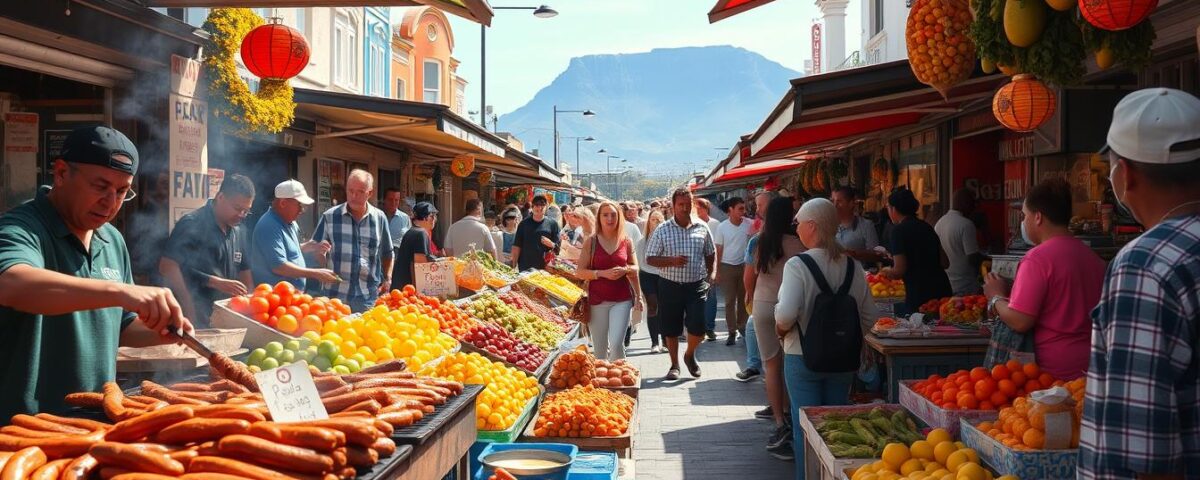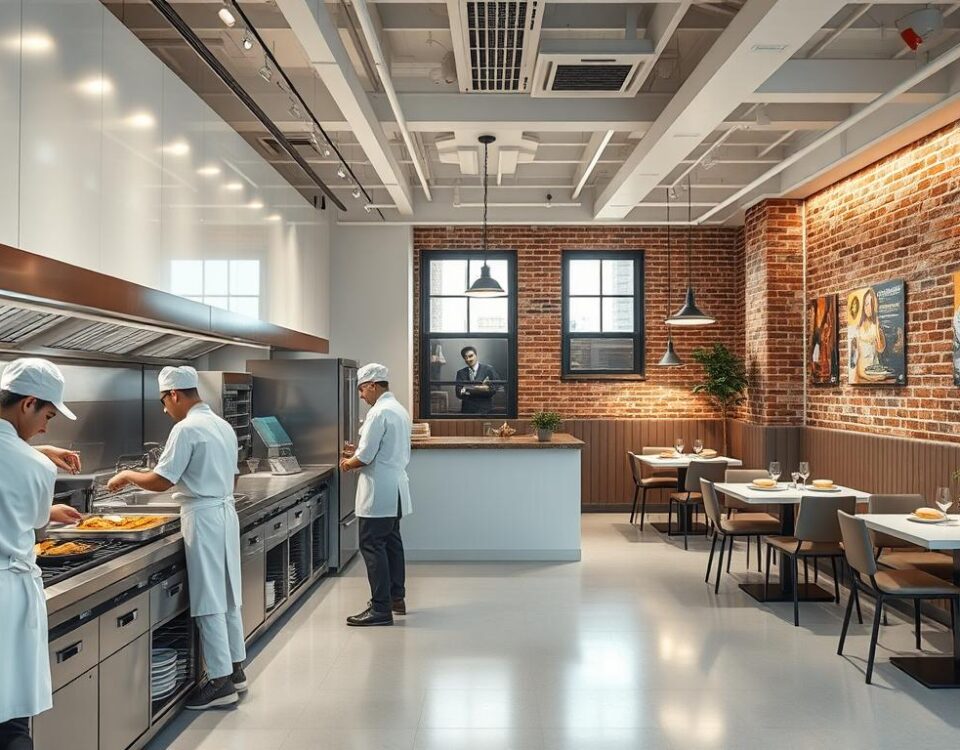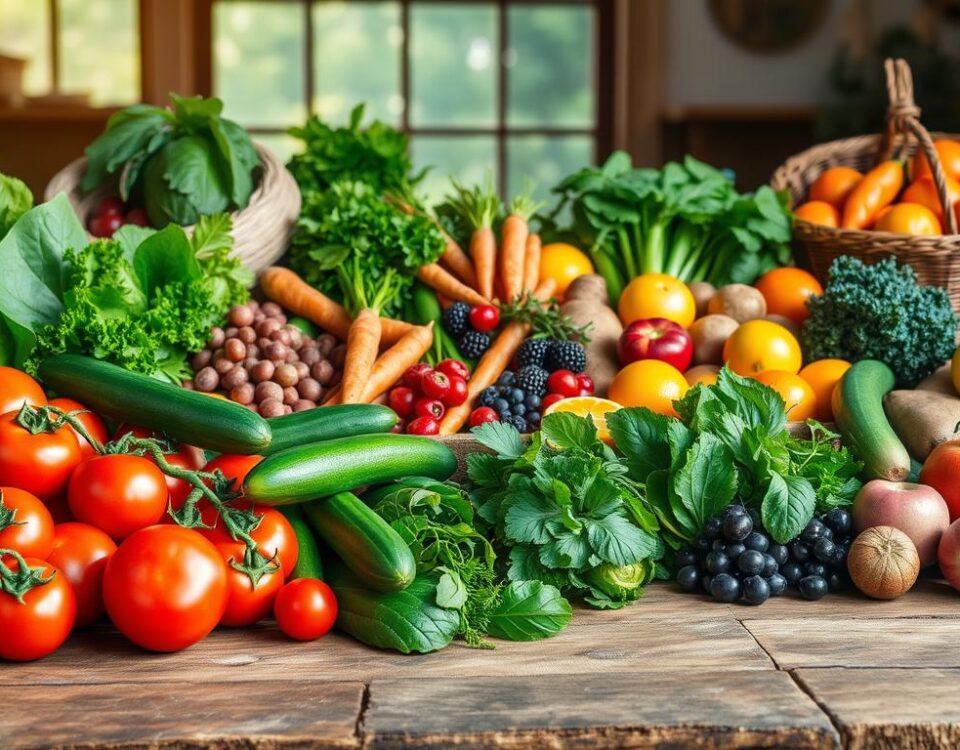
Where to Eat in Brussels for the Perfect Waffle, Chocolate, and Beer Combo
June 13, 2025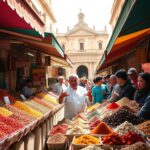
How to Taste the Spice and Soul of Lima in Just One Day
June 14, 2025Did you know that over 70% of travelers say trying local dishes shapes their entire trip? I’m standing at the edge of Bo-Kaap, a rainbow-colored neighborhood, feeling that truth in my bones. My adventure begins here, where the scent of Cape Malay curry—a blend of spices tracing back centuries—dances through the air. “Every bite feels like a story,” says Sam C, a fellow traveler I met earlier. I couldn’t agree more.
What excites me most isn’t just the food itself, but how it ties to this city’s soul. Small, family-run spots like the ones Eat Like a Local describes “aren’t just meals—they’re handshakes with history.” Take Natasha B’s advice: follow the laughter and sizzle of pans in hidden alleys. That’s where magic happens.
I’ve already booked a tour with a passionate guide who promises tales of Dutch settlers, Indigenous traditions, and fusion flavors. As I wander past street vendors grilling sosaties (skewered meat) and bakeries selling koeksisters (syrupy doughnuts), I realize food here isn’t just eaten—it’s experienced. And that’s what makes this place unforgettable.
Key Takeaways
- Cape Town’s cuisine connects deeply to South Africa’s multicultural history.
- Locally owned restaurants offer immersive, authentic dining experiences.
- Guided tours blend storytelling with tastings for richer exploration.
- Neighborhoods like Bo-Kaap showcase vibrant culture through food.
- Dishes like Cape Malay curry tell stories of migration and tradition.
- Street food and hidden gems often provide the most memorable meals.
My Cape Town Food Adventure Begins
My obsession with authentic flavors led me straight to South Africa’s vibrant heart. I wanted more than meals—I craved stories served on plates. That’s how I found myself booking a culinary tour described by Eat Like a Local as “a passport to the city’s soul.”
https://www.youtube.com/watch?v=23QqOxZWS20
Why I Chose This Culinary Journey
Three years ago, a friend handed me a koeksister from a family recipe. Its sticky sweetness sparked my curiosity. When National Geographic Traveller called this city “a living mosaic of flavors,” I knew I had to taste it firsthand.
Setting the Scene in Cape Town
Breezy Atlantic winds carried scents of turmeric and smoked meat as I walked. Historic neighborhoods unfolded like pages—pastel buildings in Bo-Kaap, spice markets buzzing with vendors. Our guide pointed to a weathered doorway: “That’s where generations shared bunny chow during apartheid.”
| Location | Experience | Historical Insight |
|---|---|---|
| Bo-Kaap | Tasting samoosas | Malay slave influence |
| Greenmarket Square | Spice blending demo | 17th-century trade hub |
| Kloof Street Café | Rooibos tea pairing | Indigenous plant uses |
Local guides transformed bites into time travel. A Xhosa chef once told me, “Our dishes carry ancestors’ whispers.” That intimacy—the way strangers became friends over shared pots—defined my start here.
Discovering Iconic South African Dishes
Have you ever tasted a dish that felt like a history lesson? My fork became a time machine as I dove into Cape Malay classics and smoky braai feasts. Each bite revealed layers of migration, resilience, and creativity—ingredients as vital as the spices themselves.
Savoring Cape Malay Classics
At a family-run restaurant in Bo-Kaap, I tried bredie—a slow-cooked stew blending lamb, tamarind, and cinnamon. Our host explained how 17th-century Malay slaves used local ingredients to recreate memories of home. National Geographic Traveller calls this “culinary alchemy,” and I finally understood why.
The fluffy roti served alongside my curry carried whispers of Dutch colonization. Yet, the vibrant yellow turmeric spoke of trade routes stretching to Indonesia. Every meal here balances boldness with comfort—like the samoosas I devoured, their crispy shells hiding spiced minced chicken.
Exploring Traditional Braai Experiences
Saturday afternoons here mean one thing: braai. At a local gathering, I watched marinated meats sizzle over fragrant rooikrans wood. Eat Like a Local’s guide grinned: “This isn’t just grilling—it’s our national pastime.”
I tasted:
- Boerewors: Spiral sausages with coriander undertones
- Chakalaka: Fiery vegetable relish born in township kitchens
- Pap: Maize porridge soaking up smoky juices
As the sunset painted Table Mountain gold, I realized these flavours don’t just feed bodies—they stitch communities together. And isn’t that the best kind of meal?
Tasting the World on a Plate in Cape Town
What if you could circle the globe through your taste buds? That’s exactly what happened when I explored the city’s fusion cuisine—where Japanese miso meets Cape Malay spices, and Mexican tacos get a rooibos-infused makeover. National Geographic Traveller nailed it: “Innovation here isn’t trendy—it’s tradition.”
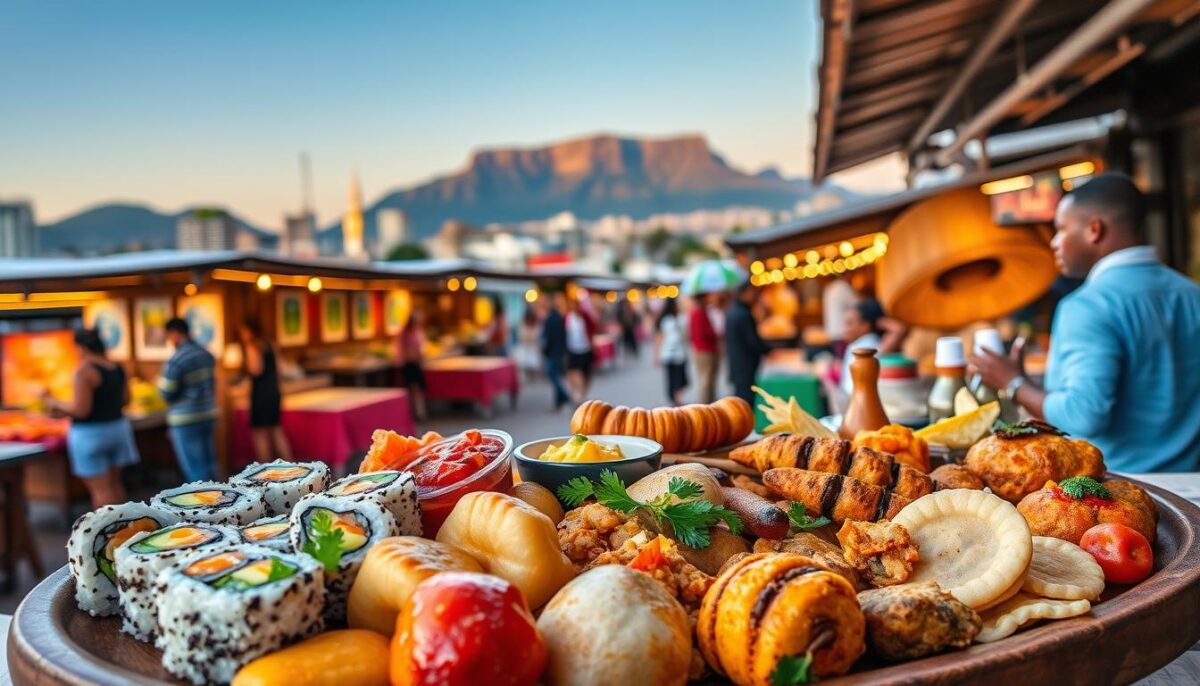
Where Borders Blur on the Plate
At a Wale Street eatery, I bit into Korean-style bobotie—a minced meat dish layered with kimchi. Our guide winked: “This is how we roll in the Western Cape—borrowing flavors, not copying them.” The heat of gochujang danced with sweet apricot jam, creating something entirely new yet deeply local.
| Dish | Global Influence | Local Twist |
|---|---|---|
| Peri-Peri Sushi | Japanese technique | African bird’s eye chili |
| Malabar Curry Pizza | Italian base | Durban-inspired sauce |
| Rooibos Espresso | European coffee culture | Indigenous herbal tea |
In the city centre, I joined a food tour group that felt like a United Nations meeting. We swapped stories over samoosas stuffed with Thai basil, laughing as spices sparked both tears and joy. One chef told me: “Our kitchen speaks six languages—just like our customers.”
Every meal became a passport stamp. From Portuguese-inspired prego rolls at a community market to French patisseries using fynbos honey, the creativity floored me. It’s not fusion—it’s conversation. And everyone’s invited.
Embarking on a Cape Town food journey
What separates good trips from legendary ones? For me, it’s mastering the art of culinary exploration. After three immersive tours with Eat Like a Local, I’ve cracked the code for savoring this city’s flavors efficiently—and joyfully.
Exclusive Tips for Navigating Local Food Tours
Book the City Bowl Food Tour early—their 4-hour morning slots fill fast. Guides like Rupesh weave stories into every bite. “We’re not just feeding stomachs,” he told our group, “we’re connecting timelines.”
Wear broken-in sneakers—you’ll walk 2 miles between stops. Uber works best for reaching the starting location. Dietary needs? Mention them when booking. Susan, my vegan-friendly guide, surprised us with dairy-free bobotie that outshone the original.
| Tour Time | Must-Try Dish | Pro Tip |
|---|---|---|
| Morning | Masala steak Gatsby | Skip breakfast |
| Afternoon | Smoked snoek pâté | Carry wet wipes |
| Evening | Chakalaka-topped pap | Share portions |
Must-Try Stops Recommended by Locals
Locals nudged me toward a hole-in-wall spot near Greenmarket Square. Their peri-peri chicken samoosas—crispy outside, fiery inside—became my daily ritual. For dessert? A family-run bakery’s rooibos-infused malva pudding.
Balance fancy restaurants with street eats. One meal at a high-end wine estate, the next at a park bench with bunny chow. Let guides suggest detours—that’s how I found a spice merchant sharing 100-year-old curry blends.
Ready? Your taste buds will thank you. Just remember: every meal here is a conversation starter. Bring curiosity—and elastic waistbands.
Uncovering Hidden Gems & Local Food Favorites
The real magic happens when you step off the postcard-perfect paths. My “aha moment” came at Mariam’s Kitchen—a family-run restaurant tucked behind a laundromat. Their Gatsby sandwich, stuffed with spicy chicken and golden fries, stretched longer than my forearm. “This is where we eat,” whispered a local regular, winking as sauce dripped down my wrist.
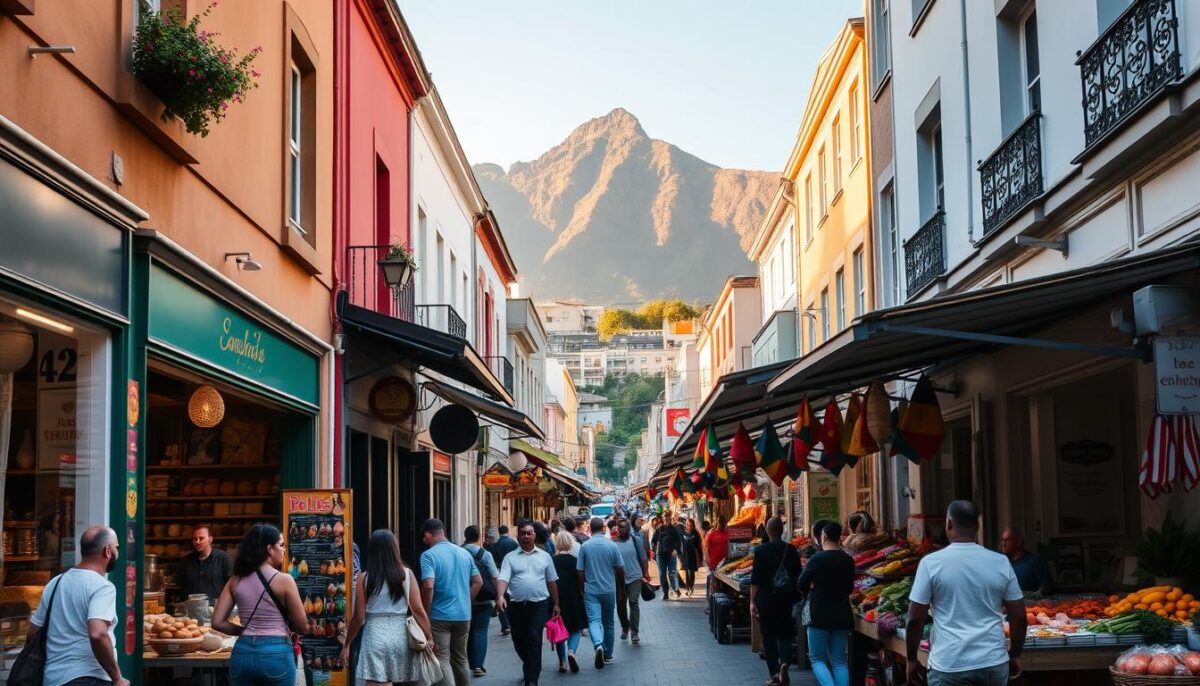
Exploring quieter areas like Woodstock revealed treasures no algorithm suggests. At a spice shop run by third-generation traders, I learned why locals swear by home-blended masalas. The owner handed me a vial: “This paprika survived apartheid—it’s our history in powder form.”
Small-group tours became my compass. Guides led us past crowded streets to a courtyard where grandmothers fry vetkoek (savory doughnuts) using recipes older than the city itself. One cook chuckled: “Google Maps can’t find this place—but your taste buds will remember.”
Here’s the fact: chasing authenticity means trusting whispers over billboards. Let taxi drivers recommend lunch spots. Follow handwritten signs to dishes that redefine “hole-in-the-wall.” This community-driven approach turns meals into time capsules—and every bite into a secret handshake.
Cultural and Historical Tastes that Define the City
“Every spice here has a shadow,” remarked a third-generation chef as she stirred a pot of bobotie. This savory-sweet dish—layered with curried meat and custard—mirrors South Africa’s layered history. Recipes here aren’t just meals; they’re edible archives.
Stories Behind Time-Honored Recipes
At a family-run restaurant in District Six, I learned how apartheid reshaped local cuisine. “We cooked with what we had,” the owner shared, serving me a steaming bowl of waterblommetjie bredie. This water lily stew, once a survival dish, now stars on menus across the city.
National Geographic Traveller notes Cape Malay curries evolved as “culinary resistance”—enslaved people preserving identity through spice blends. I tasted this resilience in a single bite of dhaltjie (chili bite), its heat balanced by centuries of adaptation.
Iconic Neighborhoods and Their Signature Dishes
Bo-Kaap’s candy-colored houses guard secrets in their kitchens. Here, samoosas arrive stuffed with chicken and history—each fold representing generations of Malay influence. Eat Like a Local’s guide explained: “These recipes crossed oceans but never lost their soul.”
In Langa township, communal pots bubble with umngqusho (samp and beans). A local grandmother chuckled as I tried it: “You’re eating democracy—different ingredients working together.” Her words crystallized how South African dishes mirror societal progress.
The Ultimate Food Tour Experience in Cape Town
Guided tours transform meals into memories—here’s how. My day began at a sunlit square where our group met, armed with empty stomachs and curiosity. “We’re not just eating,” our guide Zara said, “we’re decoding the city’s DNA.” Over four hours, we zigzagged through cobblestone streets, tasting everything from rooibos-infused espresso to chicken sosaties glazed with apricot chutney.
What to Expect on a Guided Food Tour
Prepare for sensory whiplash in the best way. Tours typically hit 6-8 stops—think spice markets whispering tales of 17th-century traders, then rooftop wine pairings with Table Mountain views. Wear comfy shoes: you’ll cover 1.5 miles between a heritage bakery and a hole-in-the-wall cuisine gem. My group gasped at a bite of bobotie spring roll—a fusion twist even locals applaud.
| Stop Type | Sample Dish | Pro Tip |
|---|---|---|
| Morning Market | Koeksister doughnuts | Bring reusable containers |
| Afternoon Café | Rooibos latte | Ask for extra foam |
| Evening Braai | Boerewors skewers | Chat with the grill master |
Planning Your Perfect Culinary Route
Book through vetted operators like Hungry Soles—their 9 AM slots sell out fast. Uber to the meeting location; parking’s a nightmare. Dietary restrictions? Mention them when reserving. Our vegan traveler got crispy cauliflower “biltong” that rivaled the real deal.
Leave room for spontaneity. When rain canceled our courtyard tasting, Zara pivoted to a home kitchen where a grandmother taught us to fold samoosas. “Recipes adapt,” she laughed, “just like us.” That’s the magic here—every meal becomes a shared story.
Conclusion
As the sun dips below Table Mountain, I realize this coastal hub’s true magic lies in its edible narratives. Every meal here—from Cape Malay curries simmering with ancestral pride to smoky braai feasts uniting strangers—became chapters in a living history book. National Geographic Traveller put it best: “You don’t just taste South Africa here—you digest its soul.”
My most vivid memories? The laughter shared over samoosas on Wale Street, and the elderly vendor who whispered, “Our recipes survived storms—literal and political.” These experiences transformed simple bites into time capsules of resilience.
Want to uncover these layers yourself? Start in the buzzing city centre, where Eat Like a Local guides decode hidden stories behind street food. Let taxi drivers direct you to family-run spots in the Western Cape—that’s how I found chili-infused chocolate at a hole-in-the-wall bakery.
Great meals here aren’t about perfection. They’re about the grandmother teaching you to fold dough in her courtyard, or the way history seeps into every spice blend. So pack curiosity over expectations. Let your taste buds wander dusty streets and sleek markets alike. Because in this corner of South Africa, every flavor has a heartbeat.
FAQ
What makes South African cuisine unique?
The blend of indigenous, Malay, Dutch, and other global influences creates bold, layered flavors. Think fragrant curries, smoky grilled meats, and fresh seafood paired with local wines.
How do I find authentic Cape Malay dishes?
Head to Bo-Kaap, a historic neighborhood in the city center. Family-run spots like Biesmiellah or Bo-Kaap Kombuis serve classics like bobotie or samosas with generations-old recipes.
Are guided food tours worth it?
Absolutely! Companies like Cape Town Culinary Tours or African Storybook connect you with hidden gems and stories you’d miss alone. Plus, you’ll skip the hassle of planning routes.
What’s a “braai” and where can I try one?
A braai is South Africa’s answer to barbecue, often featuring sosaties (skewered meat) or boerewors sausage. Join locals at markets like Oranjezicht City Farm Market for a casual, communal experience.
Which areas have the best fusion food?
The City Bowl and Wale Street are hotspots. Restaurants like Kloof Street House mix global techniques with local ingredients—try their peri-peri chicken or snoek fish cakes.
What underrated spots do locals love?
Eastern Food Bazaar offers budget-friendly street eats, while Truth Coffee Roasting in the CBD serves artisanal brews with quirky steampunk vibes. Don’t miss hole-in-the-wall bakeries for koeksisters!
How does history shape the food here?
From spice trade routes to apartheid-era resilience, dishes like bredie (stew) or malva pudding carry stories of survival, adaptation, and community. Every bite has a backstory.
What’s essential for planning a food-focused trip?
Book popular restaurants early, wear comfy shoes for walking tours, and ask servers for regional wine pairings. Most importantly, come hungry—portions are generous!
